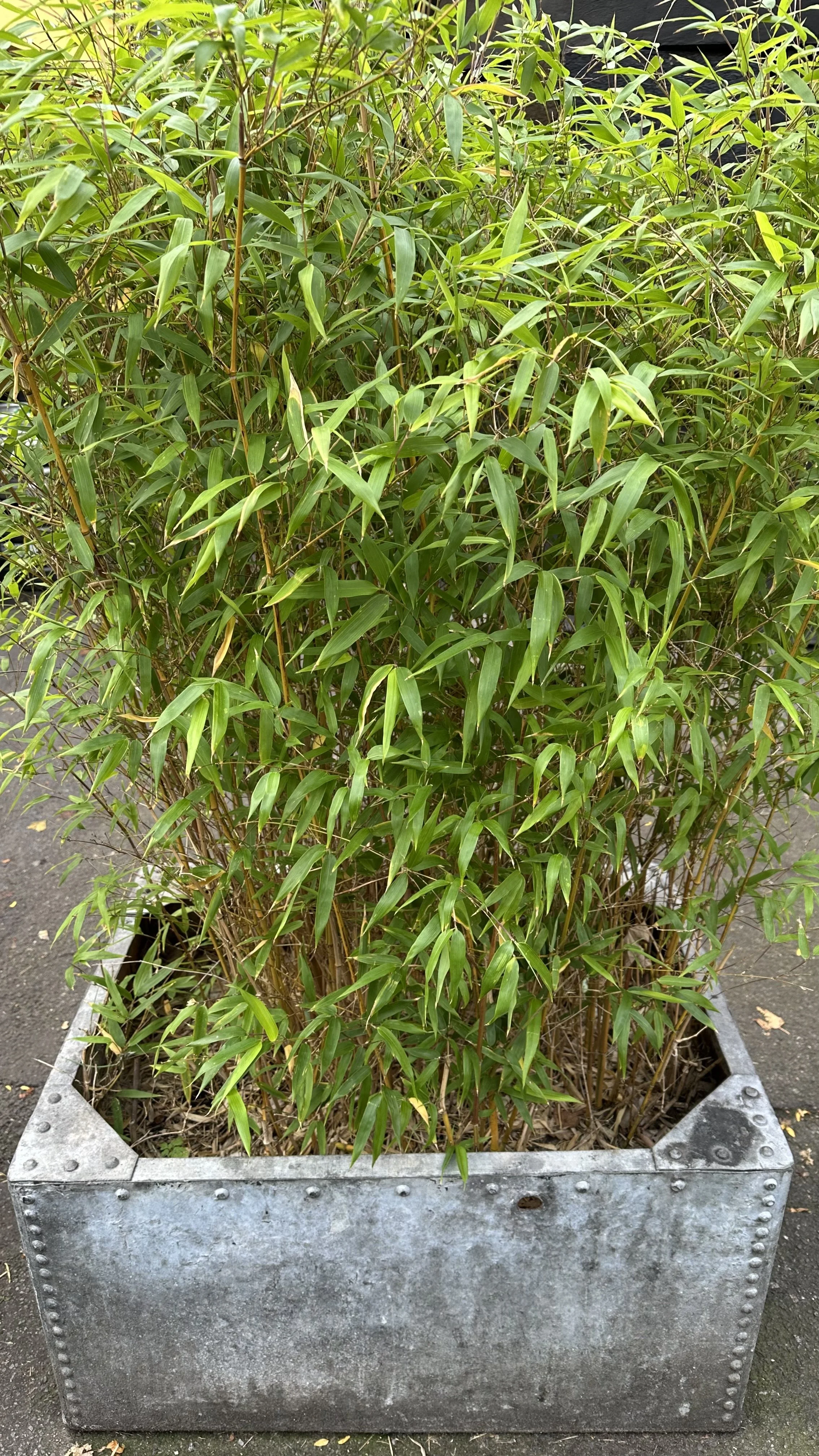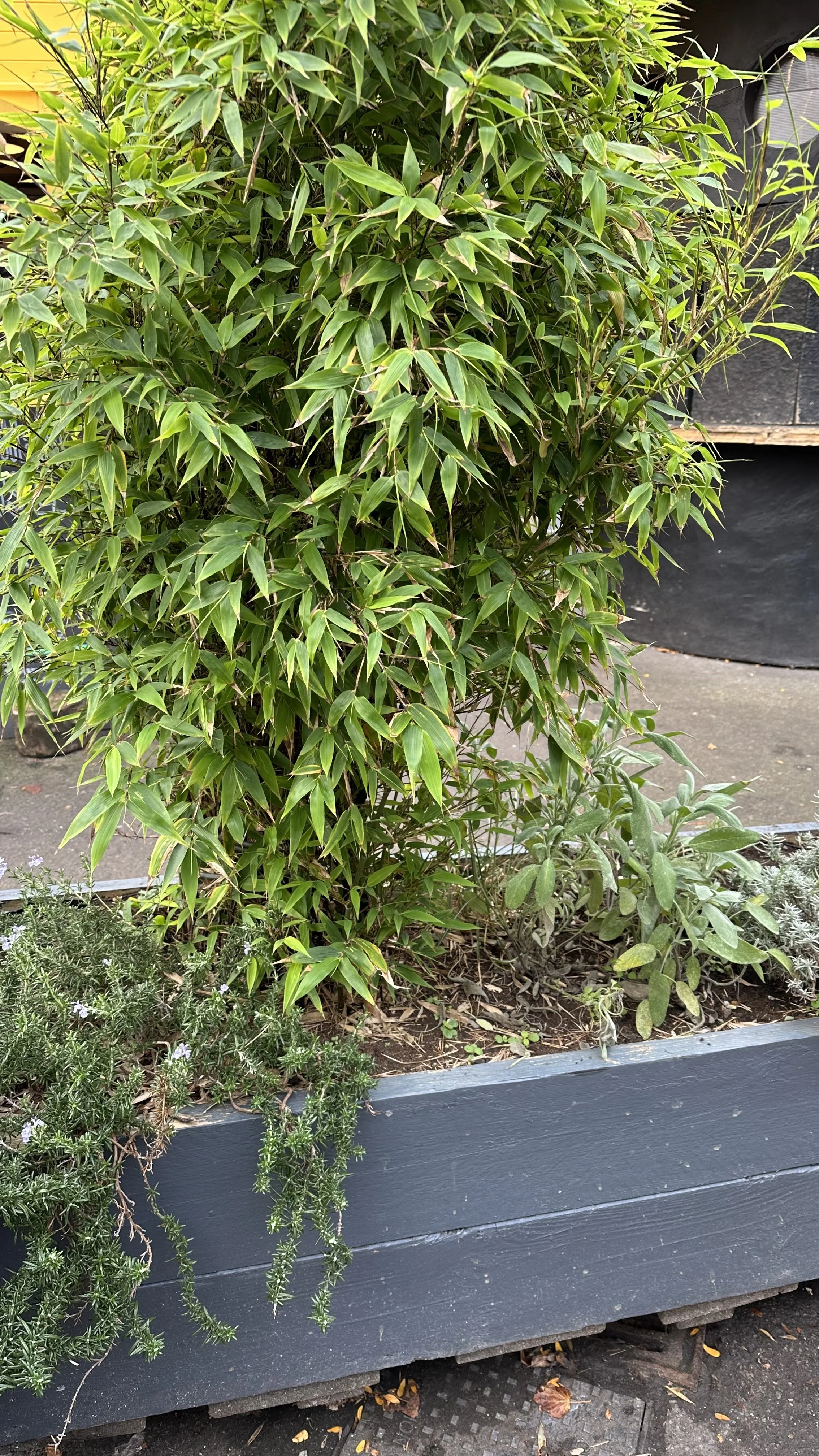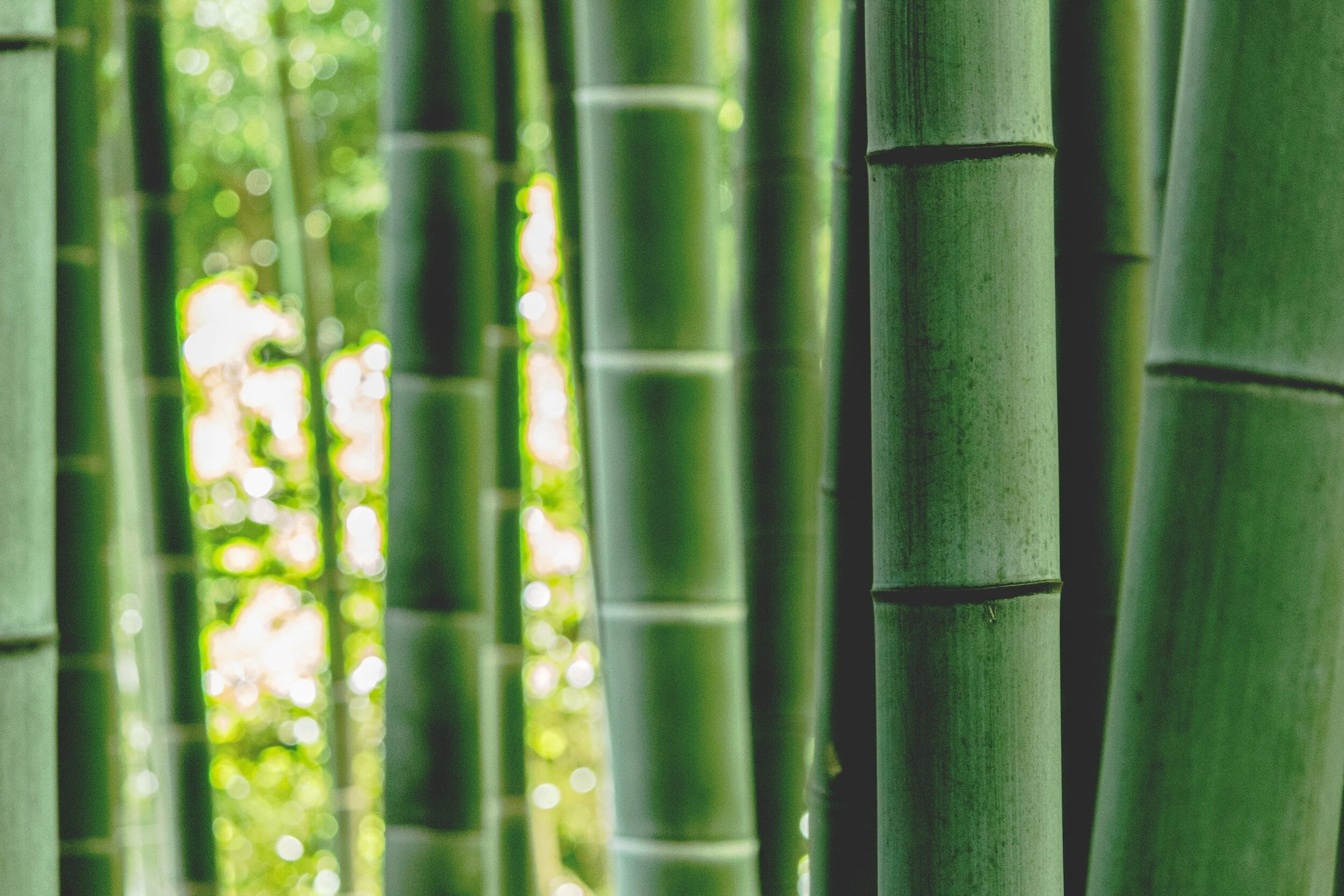How to Grow Bamboo in Pots: A Simple Guide
This article has links to products that I may make commission from.
Bamboo, with its elegant and serene presence, has long been a favorite in both outdoor gardens and indoor spaces.
Growing bamboo in pots is a fantastic way to bring this touch of natural grace into your home or onto your patio.
This guide will walk you through everything you need to know about nurturing bamboo in containers.
From selecting the right species to the nuances of care, let's dive into the world of growing bamboo in pots.
Want to learn more about container gardening? Check out my guides:
Choosing the Right Bamboo Species
Selecting the appropriate bamboo species is a fundamental step when planning to grow bamboo in pots.
The choice of species greatly impacts the plant's growth habit, care requirements, and the overall aesthetic you can achieve.
Generally, bamboos are categorized into two main types: clumping and running.
Each has distinct characteristics and is better suited for different purposes and environments.
Clumping Bamboo
Clumping bamboo grows in tight clusters, expanding slowly over time.
This type tends to be more manageable and less invasive, making it an ideal choice for container growing.
My Recommended Clumping Bamboo Species:
Fargesia:
Known for its hardiness and suitability for colder climates.
It's perfect for outdoor pots and can also act as a screening plant.
Here is the Faregesia bamboo I recommend:
Bambusa:
A tropical clumping variety, Bambusa is well-suited for larger containers and creates a visually striking presence.
It's ideal for creating a focal point in gardens or patios.
Here is the Bambusa bamboo I recommend:
Thamnocalamus:
This species often features delicate foliage and a more compact growth habit, making it excellent for smaller spaces or indoor pots.
Here is the Thamnocalamus bamboo I recommend:
Running Bamboo
Running bamboo species are known for their aggressive growth and spreading habit.
They send out long rhizomes that can quickly take over a space.
In pots, they require more diligent control and frequent repotting.
If you opt for running bamboo, choose a large container and be prepared for more maintenance.
Regular root pruning and repotting are essential to prevent the bamboo from becoming root-bound and to control its vigorous growth.
My Recommended running Bamboo Species:
Phyllostachys:
A common running bamboo, known for its height and rapid growth.
It requires significant space and is better suited for large, outdoor containers.
Here is the Phyllostachys bamboo I recommend:
Pseudosasa japonica:
This species can adapt to a variety of climates and is often used for screening purposes.
It needs ample space and regular pruning when grown in pots.
For more inspiration, check out my guide: The Best Gifts for Gardeners.
Considerations for Indoor and Outdoor Growing
Indoor Varieties:
For indoor growing, smaller, less vigorous species like Lucky Bamboo (Dracaena sanderiana, not a true bamboo) are perfect.
These species adapt well to indoor conditions and require less sunlight.
Here is the Lucky Bamboo I recommend:
Outdoor Varieties:
When selecting bamboo for outdoor pots, consider the climate and available space.
Hardy clumping varieties like Fargesia are excellent for colder climates, while Bambusa and Thamnocalamus are suited for warmer areas.
Aesthetic and Practical Aspects
Size and Growth Pattern:
Consider the ultimate size and growth pattern of the bamboo.
Smaller varieties are better for indoor pots, while larger species are more suited for outdoor containers where they have more space to grow.
Leaf Shape and Color:
Different bamboo species offer a variety of leaf shapes and colors.
Some have variegated leaves, while others feature striking cane colors that can add to the aesthetic appeal.
By carefully selecting the right bamboo species for your pots, you can ensure not only the health and manageability of the plant but also achieve the desired look and feel for your space, be it indoors or outdoors.
Learn how to grow more in containers with my guide:
Selecting and Preparing the Container
When it comes to growing bamboo in pots, the choice of container plays a pivotal role in the health and growth of the plant.
Bamboo has unique requirements, especially regarding root space and drainage.
Here's a detailed look at how to select and prepare the right container for your bamboo plants.
Size Matters
Container Size:
The size of the container is critical. Bamboo plants are known for their vigorous root systems.
A pot that is too small will restrict growth and may lead to a root-bound plant, while a pot that is too large can lead to waterlogged soil.
Generally, a container with a diameter of 18 to 36 inches is suitable for most bamboo species.
Depth:
Besides width, depth is also important.
Bamboo roots tend to grow downwards before spreading out.
A deep pot ensures adequate room for root development.
Here is the container for bamboo I recommend:
Choosing the Right Material
Material Types:
Containers can be made from various materials like terra cotta, ceramic, wood, or plastic.
Each has its advantages and disadvantages.
Terra Cotta and Ceramic:
These materials are heavy, which helps stabilize taller bamboo plants, but they can be prone to cracking in freezing temperatures.
Wood:
Wooden containers offer good insulation but may rot over time unless treated.
Plastic:
Lightweight and durable, plastic pots are a versatile choice, though they may not offer the same aesthetic appeal as terra cotta or ceramic.
Aesthetics vs. Functionality:
The choice of material can also depend on aesthetic preferences and the specific environment where the pot will be placed.
Importance of Drainage
Drainage Holes:
Adequate drainage is essential for bamboo.
Make sure the pot has sufficient drainage holes at the bottom.
Bamboo does not like to sit in waterlogged soil, which can lead to root rot.
Improving Drainage:
If necessary, increase the number of drainage holes or enlarge existing ones.
Placing a layer of gravel or broken pottery pieces at the bottom of the pot can also help improve drainage.
Preparing the Container
Cleaning the Pot:
If reusing a pot, clean it thoroughly to remove any salt deposits or remnants of previous plants, which can potentially harm the bamboo.
Lining:
For wooden containers, consider lining them with a plastic liner to prevent rot.
Ensure the liner has holes aligned with the container's drainage holes.
Pot Placement
Stability and Mobility:
Consider the weight and mobility of the pot, especially for large bamboo species.
Once filled with soil and the plant, the pot can become quite heavy.
If you plan to move it around, consider using a pot with wheels or placing it on a wheeled stand.
Location:
Place the pot in a suitable location considering the light requirements of the bamboo species.
Some species prefer full sun, while others thrive in partial shade.
By carefully selecting and preparing the right container, you can provide a healthy environment for your bamboo to grow, ensuring both the wellbeing of the plant and the aesthetic integration into your space.
Expand your container garden with my easy guides:
Planting Bamboo in Pots
Planting bamboo in pots is a critical process that sets the stage for the health and growth of the plant.
Proper planting ensures that the bamboo has the best start possible in its new container environment.
Below are detailed steps and considerations for planting bamboo in pots.
Soil Selection
Choosing the Right Soil:
The best soil for bamboo in pots is a well-draining potting mix.
Bamboo prefers a loamy soil that retains moisture yet drains well.
Avoid using garden soil as it can be too heavy and may not provide adequate drainage.
Learn more about this in my guide Garden Soil vs. Potting Soil: How to Choose the Right One.
Here is the potting mix for bamboo I recommend:
Preparing the Bamboo Plant
Root Inspection:
Before planting, inspect the bamboo's root ball.
Trim any circling or overly long roots to encourage outward growth.
Hydration:
If the root ball is dry, soak it in water for a few hours before planting to ensure the roots are well-hydrated.
Planting Process
Filling the Pot:
Fill the pot with the prepared soil mix, leaving enough space to accommodate the bamboo's root ball.
Positioning the Plant:
Place the bamboo in the center of the pot.
The top of the root ball should be just below the rim of the pot, allowing space for watering.
Adding Soil:
Fill in around the root ball with more soil mix, gently tamping down to remove any large air pockets.
Watering:
Water the plant thoroughly after planting.
This helps settle the soil around the roots and eliminates air pockets.
Post-Planting Care
Initial Positioning:
After planting, place the pot in a shaded area for a few days to allow the plant to recover and adjust to its new environment.
First Weeks Care:
Monitor the bamboo closely for the first few weeks.
Keep the soil consistently moist but not waterlogged.
Adjust watering based on weather conditions and the bamboo's needs.
Staking:
If the bamboo is tall or top-heavy, provide support with a stake until it establishes itself in the new pot.
Long-Term Considerations
Monitoring Growth:
Keep an eye on the bamboo's growth.
Potted bamboo can become root-bound over time.
If the plant seems to be outgrowing its pot, consider repotting into a larger container.
Seasonal Adjustments:
Be mindful of seasonal changes.
Bamboo in pots may require more frequent watering in hot, dry weather and less in cooler, wetter conditions.
By following these detailed steps for planting bamboo in pots, you can ensure a healthy and robust growth for your bamboo plants.
Regular monitoring and adjustments to care will help your potted bamboo thrive in its container environment.
For more tips and inspiration, check out my guides:
Bamboo Care in Pots
Caring for bamboo in pots involves a balanced approach to watering, feeding, pruning, and overall maintenance.
Potted bamboo has different needs compared to bamboo planted in the ground, and understanding these nuances is key to successful growth.
Watering
Consistency is Key:
Bamboo plants prefer consistent moisture.
The goal is to keep the soil evenly moist, but not waterlogged.
Overwatering can lead to root rot, while under-watering can stress the plant.
For more watering tips, check out my guide How to Use Watering Globes.
Monitoring Soil Moisture:
Check the soil moisture regularly by feeling the top inch of the soil. If it's dry, it's time to water.
In hot, dry weather, bamboo may need more frequent watering, sometimes daily.
Watering Technique:
When watering, do so thoroughly until water runs out of the drainage holes.
This ensures the entire root system is hydrated.
This is a great way to use rainwater collected in a water butt.
Check out my guide: Water Butts: Sustainable Water Storage for Your Garden.
Feeding
Fertilizer Requirements:
Bamboo benefits from regular feeding during the growing season.
Use a balanced, slow-release fertilizer formulated for container plants.
Application Frequency:
Apply fertilizer according to the product instructions, usually every few months during the spring and summer.
Here is the fertilizer I recommend:
Pruning and Maintenance
Pruning for Health:
Regular pruning helps maintain the desired shape and size of the bamboo.
It also encourages new growth and can prevent the plant from becoming too top-heavy.
Removing Dead or Yellowing Leaves:
Periodically remove any dead or yellowing leaves and culms (bamboo stalks) to keep the plant healthy and improve its appearance.
Root Pruning:
Every few years, root pruning may be necessary to prevent the bamboo from becoming root-bound.
This involves removing the plant from the pot, trimming back the roots, and replanting in fresh soil.
Winter Care
Protection from Cold:
In colder climates, potted bamboo needs protection during the winter.
Move pots to a sheltered area, or wrap the pot in burlap or bubble wrap to insulate the roots.
Reduced Watering in Winter:
Water less frequently in winter, as bamboo's growth slows and the risk of waterlogging increases due to lower evaporation rates.
Pest and Disease Management
Regular Inspection:
Keep an eye out for signs of pests or diseases.
Common issues include aphids, spider mites, and fungal infections.
Treatment:
Use appropriate organic or chemical treatments as necessary.
Always follow the product instructions and consider the environmental impact.
Repotting
Signs for Repotting:
If the bamboo seems to be outgrowing its pot or the growth appears stunted, it may be time to repot.
Other signs include roots growing through the drainage holes or the soil drying out too quickly.
Repotting Process:
Choose a larger pot and fresh potting mix.
Carefully remove the bamboo from its current pot, trim the roots if necessary, and replant.
Environmental Considerations
Light Requirements:
Bamboo generally prefers bright, indirect light.
Some species can tolerate full sun, while others need partial shade.
Adjust the placement of your pots to suit the specific light needs of your bamboo.
By following these detailed care instructions, your bamboo in pots can thrive and bring a sense of natural beauty to your indoor or outdoor spaces.
Regular attention and adjustments based on seasonal changes and the plant's growth will ensure its long-term health.
For more tips, check out my guide:
Creative Ideas for Bamboo in Pots
Incorporating bamboo into your home and garden through pots is not just about growing a plant; it's about adding a touch of elegance, tranquility, and natural beauty to your space.
Here are some creative ideas for using bamboo in pots to enhance your surroundings.
Indoor Decoration
Living Room Accents:
Place tall bamboo pots in corners of your living room to add a fresh and vibrant look.
Bamboo varieties with interesting cane colors or leaf variegations can become focal points.
Bathroom Oasis:
Transform your bathroom into a spa-like retreat with smaller bamboo plants.
The humidity of the bathroom creates a favorable environment for many bamboo species.
Office Greenery:
A potted bamboo on your desk or in a corner of your office can be a calming presence, helping to reduce stress and improve focus.
Outdoor Landscaping
Patio Privacy Screens:
Use bamboo in pots to create natural, movable screens on your patio or balcony.
This not only adds privacy but also introduces a lush, green element to your outdoor living space.
Garden Accents:
Integrate potted bamboo into your garden landscape as accent plants.
They can be placed alongside pathways, near water features, or as part of a mixed border.
Entrance Elegance:
Flank your home's entrance with symmetrical bamboo planters.
This can create an inviting and impressive entryway.
Themed Gardens
Tropical Touch:
For a tropical theme, combine bamboo with other lush, leafy plants in pots.
The contrasting textures and shades of green can evoke the feel of a tropical paradise.
Balcony and Rooftop Gardens
Vertical Interest:
On balconies or rooftop gardens where space is at a premium, tall bamboo varieties can add vertical interest without taking up much floor space.
Wind Barrier:
Bamboo can also serve as a natural wind barrier, creating a more protected and comfortable space on high balconies or rooftops.
Integrating with Other Plants
Companion Planting:
Bamboo looks great when paired with other plants.
Consider underplanting with colorful annuals or perennials, or combining bamboo with ornamental grasses for a varied texture display.
Contrasting Containers:
Experiment with different pot styles and colors to complement or contrast with the bamboo, adding to the overall visual interest.
By employing these creative ideas, you can use bamboo in pots to not only enhance the beauty of your space but also create functional elements like privacy screens and wind barriers.
The versatility of bamboo makes it an excellent choice for a wide range of decorative themes and applications.
Frequently Asked Questions
Can You Grow Bamboo in a Pot Indoors?
Yes, bamboo can be successfully grown indoors, but it requires proper care. Indoor bamboo prefers bright, indirect light and consistent moisture.
Avoid placing it in direct sunlight to prevent leaf burn. Lucky Bamboo (Dracaena sanderiana), not a true bamboo, is particularly popular for indoor cultivation due to its adaptability to indoor conditions.
Regularly rotate the pot to ensure even growth and prevent the plant from leaning towards the light source.
How Often Should I Repot Bamboo?
Bamboo should be repotted every two to three years, or when it becomes root-bound.
Signs that your bamboo needs repotting include roots emerging from the drainage holes, soil drying out quickly, and slowed growth.
When repotting, choose a pot that is slightly larger than the current one and use fresh potting soil to encourage healthy growth.
Can Potted Bamboo be Transplanted to the Ground?
Yes, bamboo grown in pots can be transplanted to the ground.
The best time to do this is in the spring or early fall.
When transplanting, ensure that the species is suitable for your outdoor climate and soil conditions.
Gradually acclimate the bamboo to outdoor conditions over a week or two to prevent shock.
How to Control Bamboo Growth in Pots?
To control the growth of bamboo in pots, regular pruning is essential.
Trim both the foliage and the roots as needed.
Choosing a clumping variety can also help manage growth, as they are less aggressive than running types.
Repotting and dividing the bamboo every few years will also help keep it at a manageable size.
Want to learn more about container gardening? Check out my guides:












































